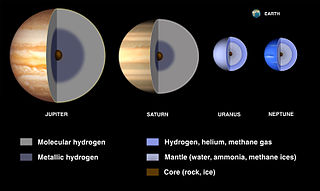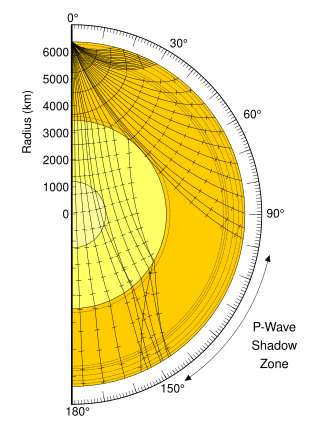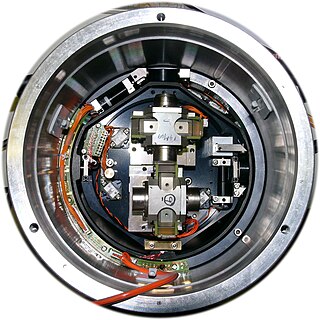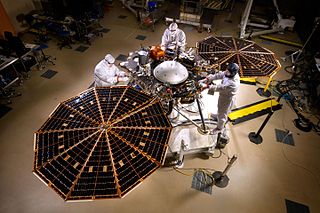

Lunar seismology is the study of ground motions of the Moon and the events, typically impacts or moonquakes, that excite them.


Lunar seismology is the study of ground motions of the Moon and the events, typically impacts or moonquakes, that excite them.
Several seismographic measuring systems have already been installed on the Moon and their data made available to scientists (such as those from the Apollo Lunar Surface Experiments Package). The existence of moonquakes was an unexpected discovery from seismometers placed on the Moon by Apollo astronauts from 1969 through 1972. The Apollo 11 instrument functioned through August of the landing year. The instruments placed by the Apollo 12, 14, 15, and 16 missions were functional until they were switched off in 1977. [1] [2] Moonquakes are not believed to be caused by tectonic plate movement (as earthquakes are), but by tidal forces between Earth and the Moon. [3] Further data is needed to clarify the origins and effects of the forces causing moonquakes.
The Chandrayaan-3 mission by Indian Space Research Organisation had a payload ILSA (Instrument for Lunar Seismic Activity), to acquire data about moonquakes. It detected a presumed natural event on 26 August. [4] It is suspected to be a moonquake. [5]
Several categories of moonquakes were recorded. Hundreds of deep moonquakes were recorded along with 28 shallow events. The deeper quakes are caused by tidal forces with the Earth and tended to occur in clusters. [6] [7] The shallow events have tectonic origins. Although more rare than deep events, the shallow events were larger, with body wave magnitudes > 5.5 and stress drops exceeding 100 MPa. [8] Other sources of seismic activity included meteorite impacts and artificial signals from lunar modules.
One key finding was an improved understanding of the structure of the deep lunar interior, including the existence of a solid inner-core and sharp core-mantle boundary and a partial-melt layer at the base of the lunar mantle. [9] [10] [11] [12] The solid core has a radius of about 240 km and is surrounded by a much thinner liquid outer core with a thickness of about 90 km. [10] The partial melt layer sits above the liquid outer core and has a thickness of about 150 km. The mantle extends to within 45 ± 5 km of the lunar surface. [12]
This section needs to be updated.(January 2022) |
Due to the success of the Apollo seismometers, several space agencies including NASA have expressed interest in funding future seismic missions to the Moon. NASA's Planetary Science Decadal Survey for 2012-2022 [13] lists a lunar geophysical network as a recommended New Frontiers mission. The mission would be tasked with enhancing the knowledge of the lunar interior using several identical landers distributed over the lunar surface. A network of arrays would be able to better constrain lunar seismicity, especially on the far side of the Moon.
In early 2018, NASA established the Development and Advancement of Lunar Instrumentation (DALI) program. [14] DALI funds research to support the Science Mission Directorate's Planetary Science Division, including the desired lunar geophysical network. NASA awarded five DALI grants in 2024, including research on ground-penetrating radar and a magnometer system for determining properties of the lunar core. [15]

The Moon is Earth's only natural satellite. It orbits at an average distance of 384,400 km (238,900 mi), about 30 times the diameter of Earth. Over time Earth's gravity has caused tidal locking, causing the same side of the Moon to always face Earth. Because of this, the lunar day and the lunar month are the same length, at 29.5 Earth days. The Moon's gravitational pull – and to a lesser extent, the Sun's – are the main drivers of Earth's tides.

Seismology is the scientific study of earthquakes and the generation and propagation of elastic waves through the Earth or other planetary bodies. It also includes studies of earthquake environmental effects such as tsunamis as well as diverse seismic sources such as volcanic, tectonic, glacial, fluvial, oceanic microseism, atmospheric, and artificial processes such as explosions and human activities. A related field that uses geology to infer information regarding past earthquakes is paleoseismology. A recording of Earth motion as a function of time, created by a seismograph is called a seismogram. A seismologist is a scientist works in basic or applied seismology.

Geophysics is a subject of natural science concerned with the physical processes and physical properties of the Earth and its surrounding space environment, and the use of quantitative methods for their analysis. Geophysicists, who usually study geophysics, physics, or one of the Earth sciences at the graduate level, complete investigations across a wide range of scientific disciplines. The term geophysics classically refers to solid earth applications: Earth's shape; its gravitational, magnetic fields, and electromagnetic fields ; its internal structure and composition; its dynamics and their surface expression in plate tectonics, the generation of magmas, volcanism and rock formation. However, modern geophysics organizations and pure scientists use a broader definition that includes the water cycle including snow and ice; fluid dynamics of the oceans and the atmosphere; electricity and magnetism in the ionosphere and magnetosphere and solar-terrestrial physics; and analogous problems associated with the Moon and other planets.

Lunar Laser Ranging (LLR) is the practice of measuring the distance between the surfaces of the Earth and the Moon using laser ranging. The distance can be calculated from the round-trip time of laser light pulses travelling at the speed of light, which are reflected back to Earth by the Moon's surface or by one of several retroreflectors installed on the Moon. Three were placed by the United States' Apollo program, two by the Soviet Lunokhod 1 and 2 missions, and one by India's Chandrayaan-3 mission.

A planetary core consists of the innermost layers of a planet. Cores may be entirely solid or entirely liquid, or a mixture of solid and liquid layers as is the case in the Earth. In the Solar System, core sizes range from about 20% to 85% of a planet's radius (Mercury).
The Lamont–Doherty Earth Observatory (LDEO) is the scientific research center of the Columbia Climate School, and a unit of The Earth Institute at Columbia University. It focuses on climate and earth sciences and is located on a 189-acre campus in Palisades, New York, 18 miles (29 km) north of Manhattan on the Hudson River.
A quake is the result when the surface of a planet, moon or star begins to shake, usually as the consequence of a sudden release of energy transmitted as seismic waves, and potentially with great violence.

A marsquake is a quake which, much like an earthquake, would be a shaking of the surface or interior of the planet Mars as a result of the sudden release of energy in the planet's interior, such as the result of plate tectonics, which most quakes on Earth originate from, or possibly from hotspots such as Olympus Mons or the Tharsis Montes. The detection and analysis of marsquakes could be informative to probing the interior structure of Mars, as well as identifying whether any of Mars's many volcanoes continue to be volcanically active.

Having a mean density of 3,346.4 kg/m3, the Moon is a differentiated body, being composed of a geochemically distinct crust, mantle, and planetary core. This structure is believed to have resulted from the fractional crystallization of a magma ocean shortly after its formation about 4.5 billion years ago. The energy required to melt the outer portion of the Moon is commonly attributed to a giant impact event that is postulated to have formed the Earth-Moon system, and the subsequent reaccretion of material in Earth orbit. Crystallization of this magma ocean would have given rise to a mafic mantle and a plagioclase-rich crust.
The Hollow Moon and the closely related Spaceship Moon are pseudoscientific hypotheses that propose that Earth's Moon is either wholly hollow or otherwise contains a substantial interior space. No scientific evidence exists to support the idea; seismic observations and other data collected since spacecraft began to orbit or land on the Moon indicate that it has a thin crust, extensive mantle and small, dense core, although overall it is much less dense than Earth.

The Cerberus Fossae are a series of semi-parallel fissures on Mars formed by faults which pulled the crust apart in the Cerberus region. They are 1235 km across and centered at 11.28 °N and 166.37 °E. Their northernmost latitude is 16.16 °N and their southernmost latitude 6.23 °N. Their easternmost and westernmost longitudes are 174.72 °E and 154.43 °E, respectively. They can be seen in the Elysium quadrangle.

Passive seismic is the detection of natural low frequency earth movements, usually with the purpose of discerning geological structure and locate underground oil, gas, or other resources. Usually the data listening is done in multiple measurement points that are separated by several hundred meters, over periods of several hours to several days, using portable seismometers. The conclusions about the geological structure are based on the spectral analysis or on the mathematical reconstruction of the propagation and possible sources of the observed seismic waves. If the latter is planned, data are usually acquired in multiple points simultaneously, using so called synchronized lines. Reliability of the time reverse modelling can be further increased using results of reflection seismology about the distribution of the sound speed in the underground volume.

The Interior Exploration using Seismic Investigations, Geodesy and Heat Transport (InSight) mission was a robotic lander designed to study the deep interior of the planet Mars. It was manufactured by Lockheed Martin Space, was managed by NASA's Jet Propulsion Laboratory (JPL), and two of its three scientific instruments were built by European agencies. The mission launched on 5 May 2018 at 11:05:01 UTC aboard an Atlas V-401 launch vehicle and successfully landed at Elysium Planitia on Mars on 26 November 2018 at 19:52:59 UTC. InSight was active on Mars for 1440 sols.

The Apollo 14 Passive Seismic Experiment (PSE) was placed on the lunar surface on February 5, 1971, as part of the Apollo 14 ALSEP package. The PSE was designed to detect vibrations and tilting of the lunar surface and measure changes in gravity at the instrument location. The vibrations are due to internal seismic sources (moonquakes) and external. The primary objective of the experiment was to use these data to determine the internal structure, physical state, and tectonic activity of the Moon. The secondary objectives were to determine the number and mass of meteoroids that strike the Moon and record tidal deformations of the lunar surface.

The Seismic Experiment for Interior Structure (SEIS) is a seismometer and the primary scientific instrument on board the InSight Mars lander launched on 5 May 2018 for a landing on 26 November 2018; the instrument was deployed to the surface of Mars on 19 December. SEIS is expected to provide seismic measurements of marsquakes, enabling researchers to develop 3D structure maps of the deep interior. Better understanding the internal structure of Mars will lead to better understanding of the Earth, Moon, and rocky planetary bodies in general.
Fluvial seismology is the application of seismological methods to understand river processes, such as discharge, erosion, and streambed evolution. Flowing water and the movement of sediments along the streambed generate elastic (seismic) waves that propagate into the surrounding Earth materials. Seismometers can record these signals, which can be analyzed to illuminate different fluvial processes such as turbulent water flow and bedload transport. Seismic methods have been used to observe discharge values that range from single-digits up through tens of thousands of cubic feet per second (cfs).

The Passive Seismic Experiment Package (PSEP) was a scientific experiment deployed on the lunar surface by the astronauts of Apollo 11 as part of the Early Apollo Surface Experiments Package (EASEP). The experiment's goal was to determine the structure, tectonic activity, physical nature, and composition of the Moon. PSEP was the first seismometer to be deployed on a planetary body other than Earth.

Seismic velocity structure is the distribution and variation of seismic wave speeds within Earth's and other planetary bodies' subsurface. It is reflective of subsurface properties such as material composition, density, porosity, and temperature. Geophysicists rely on the analysis and interpretation of the velocity structure to develop refined models of the subsurface geology, which are essential in resource exploration, earthquake seismology, and advancing our understanding of Earth's geological development.

The Lunar Surface Gravimeter (LSG) was a lunar science experiment that was deployed on the surface of the Moon by the astronauts of Apollo 17 on December 12, 1972. Conceived and led by Joseph Weber as principal investigator, the experiment aimed to measure changes in the local gravitational strength on the Moon's surface. These measurements were intended to provide insight into the internal structures of the Moon as it tidally deformed due interaction with the gravitational fields of the Earth and Sun. In addition the experiment hoped to contribute experimental evidence of the existence of gravitational waves.

The Lunar Seismic Profiling Experiment (LSPE) was a lunar science experiment, deployed by astronauts on the lunar surface in 1972 as part of Apollo 17. The goal of the LSPE was to record the seismic response generated by a variety of sources including the detonation of eight explosive charges, the ascent propulsion system on the lunar module and any natural sources.